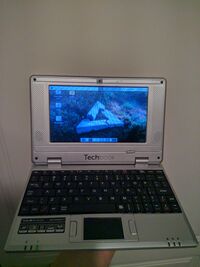Tokio Techbook (tokio-techbook)
 Tokio Techbook | |
| Manufacturer | Tokio |
|---|---|
| Name | Techbook |
| Codename | tokio-techbook |
| Released | 2012 |
| Type | laptop |
| Hardware | |
| Chipset |
Via WonderMedia 8850 |
| CPU | 1.0 GHz Cortex-A9 |
| GPU | Mali 400 |
| Display | 800x480 |
| Storage | Unknown |
| Memory | 434 MB |
| Architecture | armv7 |
| Software | |
Original software The software and version the device was shipped with. |
Android 4 (Windows CE 6?) |
Extended version The most recent supported version from the manufacturer. |
Android 4 (Windows CE 6?) |
| postmarketOS | |
| Category | testing |
Mainline Instead of a Linux kernel fork, it is possible to run (Close to) Mainline. |
yes |
pmOS kernel The kernel version that runs on the device's port. |
4.3.0 |
| Device package |
|
| Kernel package |
|
Battery Whether charging and battery level reporting work. |
Broken
|
|---|---|
Screen Whether the display works; ideally with sleep mode and brightness control. |
Works
|
| Multimedia | |
3D Acceleration |
Broken
|
Audio Audio playback, microphone, headset and buttons. |
Untested
|
Camera |
Untested
|
| Connectivity | |
WiFi |
Untested
|
| Miscellaneous | |
FDE Full disk encryption and unlocking with unl0kr. |
Untested
|
USB OTG USB On-The-Go or USB-C Role switching. |
|
| Sensors | |
Accelerometer Handles automatic screen rotation in many interfaces. |
Untested
|
Contributors
- Magnusgulin
Maintainer(s)
- Magnusgulin
Users owning this device
How to enter flash mode
There is probably no kind of flash mode or recovery mode on this device. The boot loader (uboot) checks for compiled script in path /boot/FirmwareInstall/autorun.1.wmt.
Some of these devices might also check for boot options over the built in ethernet port.
Installation
Install PMOS to sd card. Start device with the sdcard in the internal card reader of the device. You should see a text in top left corner saying "BOOTING!!"
If for some reason no text comes up, try copy the file /boot/FirmwareInstall/autorun.1.wmt to path /wmt_scriptcmd on sdcard.
General
This is a somewhat exotic version of the standard VIA / WonderMedia 8850 laptops. They should all be pretty compatible, except for
- Memory size: 128MB, 256 MB, 512 MB and 1024 MB versions seems to exist. Needs variable change in uboot script.
- Flash size: Unknown, but boots only from sd card for now. There is an unstable driver for the nand chips
- Screen: 800x480 and 1024 x 600. Should not need config change to boot.
So if you have a similar laptop there is a high possibility that this port works out of the box. Other versions of this device is known as Eken, Mid7, Mid8, Mid9, Mid10....
Wifi
Wifi is a usb dongle soldered directly to motherboard. It is triggered on and off by a magic GPIO command. This is still a work in progress.
See https://kernelhacks.blogspot.com/2012/06/arch-linux-on-wm8650-netbook.html:
Upon installing this package, to enable the WiFi chip, you have to input the command:
gpio 1:6:d8110040:d8110080:d81100c0
And to disable the WiFi chip:
gpio 0:6:d8110040:d8110080:d81100c0
Searching for 8850 uboot shows that some bootloader scripts sets a lot of GPIO pins on boot, for example:
setenv wmt.gpi.bat [0:0:00040000:d8110040:d8110080:d8110000:d8110480:d81104C0][1:0:00000020:d8110040:d8110080:d8110000:d8110480:d81104C0][2:1:00010000:d8110040:d8110080:d8110000:d8110480:d81104C0]
setenv wmt.gpo.wifi 6:0:6:d8110040:d8110080:d81100C0
setenv wmt.io.bat 3:2:1000:f25:dc4:f32:ea0:e75:e47:e12:de2:db7:d80:d3d:cfe:cbc
setenv wmt.pwbn.param 100:100:100
TODO
- Find source for "gpio" binary -> toggle gpio pin for wifi
- Get to boot with postmarketos-stable instead of 4.3.0 mainline
See also
- https://github.com/wondermedia/wm8850 official WonderMedia kernel sources (3.0.8)
- https://github.com/linux-wmt/linux-vtwm/wiki/Current-status linux-vmt testing (3.0.13). Wiki contains various info.
- https://hackaday.com/2012/06/20/cheap-arm-netbooks-have-linux-forced-upon-them/ (VIA 8650, but similar model)
- https://kernelhacks.blogspot.com/2012/06/arch-linux-on-wm8650-netbook.html (VIA 8650, contains link to wmt-gpio binary)
- pmaports!579 Initial merge request